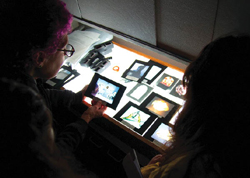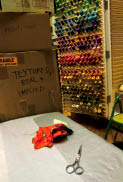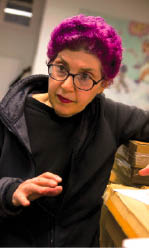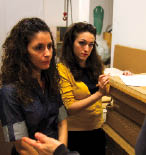Artist Appreciation
In a new TC class, students help older New York City artists catalogue their work
By Elizabeth Dwoskin
“Artists don’t retire,” says Joan Jeffri. “Many go to the studio every single day, even if it takes them an hour and a half to walk across the block to get there.” On the positive side, that often means that aging artists have what many baby boomers nearing retirement can only wish for: the energy that comes from a lifetime of meaningful work.
But artists also struggle with problems facing other older people, including financial instability, isolation and physical debilitation. And they have another problem: many have amassed hundreds or even thousands of pieces of their own work, often with no plan for preserving them after their deaths.
Those findings, from Jeffri’s 2007 study “Above Ground,” which looked at the experiences of 146 aging professional artists in New York City, have prompted her to pair 12 students this fall with a group of older professional artists in a pilot course called “Art Cart: Saving the Legacy.” The 12 student fellows are working side by side with the artists, who range in age from 68 to 92, to document the artists’ life stories and use digital archiving software to catalogue their work.
“This is something students cannot get out of a book,” says Jeffri, who directs TC’s arts administration program and its Research Center for Arts and Culture.
The interdisciplinary course, which is being funded by the National Endowment for the Arts, the TC Provost’s Investment Fund and the Pollock-Krasner Foundation, draws as much from the fields of social work, oral history and public health as it does from arts administration. Down the road, Jeffri hopes the course will be replicated at schools in other cities, and that the research will have implications for public policy, as well as offer a career venue for students.
For now, though, the artists themselves are the biggest attraction.
“We’ll be observing a lot,” Jeffri told the students on the first day, adding that they needed to pay particular attention to issues that challenge an older population. “What is their space like—is it cluttered? Do they fall a lot? How do they feel about the aging process? And what’s their level of cognitive function? How do you talk to someone who may be repeating something five times?
“You are going to be experiencing some trauma,” she concluded.
The students hailed from all over Columbia’s campus and beyond in arts administration, art education, art history, social work, public health, occupational therapy, gerontology and social work. Sadie Rubin, a student at the School of Social Work, hoped to run a retirement home one day. Danielle Katz, who was studying occupational therapy, had done fundraising for a program that connected high school students with nursing home residents. Elizabeth Berkowitz, a doctoral candidate in art history at CUNY, was researching the relationship between artists’ life stories and their artwork.
“This is really neat, because you can see an artist’s work, but you don’t always get to see the process as someone is going through it,” Berkowitz said.
Berkowitz confessed to another motive for taking the course: her grandmother is 97 and has severe dementia. “I can’t connect with her at all,” she said.
Paul Nikolaidis, a social work student, said he was excited about the course because it was contributing to a different way of viewing the aging process. “For too long, the focus on aging has only been on pathology,” he said. “To be part of something that puts a positive spin on aging is very interesting, and great.”
“Watching them experience their work all over again will be a profound experience for us,” said Vassiliki Giannopoulos, a second-year student in arts administration.
The artists, too, were a diverse lot. Betty Blayton-Taylor helped found the Children’s Art Carnival in Harlem and runs an arts school in the neighborhood. Eva Deutsch Costabel, an abstract impressionist painter, had a 35-year career designing packaging for companies like J.C. Penney and Colgate-Palmolive, and also taught at local arts colleges.
Deutsch Costabel, a Holocaust survivor, came to the first day of class wearing a silver bomber jacket with a bright orange, sequined scarf. “I’m supposed to be senile and in an old age home, but I’m not,” she said. “I’m better now than when I was young. So what’s all the fuss about young artists?”
China Marks, a maker of process-directed contemporary drawings, had dyed her hair magenta. “I expect to learn a lot and to teach a lot,” she said, when it was her turn for an introduction. Peter Ruta was enthusiastic about an eager, younger team to help him get his life in order. Ruta has painted over 3,000 canvases and said they have piled up in his Westbeth studio to the point where he and his wife could no longer find all of them.
Painter Ray Grist summed it up. “The students are going to get a depth of experience that they would not normally get from their peers,” he said. “They are going to have a good time working with me.”
Published Tuesday, Dec. 14, 2010



